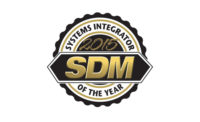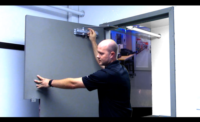UNIFIED SECURITY SYSTEMS have been around for several years now. More than just integration, these systems incorporate two or more systems into a single pane of glass — usually from a single manufacturer, giving security integrators and their customers the proverbial “one throat to choke.” While their advantages are often seen at the enterprise level, today’s unified systems can be deployed at almost any size facility; are less complex and less expensive than in the past; incorporate more integrations and technologies than ever before; and are increasingly attractive to customers.
John Becker, vice president, global sales, AMAG Technology, Hawthorne, Calif., points to two recent trends that are repositioning unified systems in the market. “One is based around maintenance and operations,” he says. “They are less complex to install and maintain. We want the integrator to be able to install on-site quickly; and when an operator is using it we want it to be simple. The other trend is the feature set. They are not just monitoring alarms or video. Today they are using analytics to parse data.”
Montreal-based Genetec was one of the early proponents of the unified security concept. Jean-Pierre Picard, manager, product marketing, has seen an evolution since those early days. “If you go back about 12 years, unified referred to mostly a video and access control combination. That was where the market was struggling the most at that time. If you look at it today, this initial mission represents only a fraction of the number of technologies used in a security operations center.” The average today is over 20, including, access control, intrusion, fire, video and other application-specific non-security processes as well, he adds.
“We used to be about the big systems, but now we are about providing the platform to take in all these disparate sources of data. It looks at a security event — whatever that comprises — and gives information you need to make decisions. All the security systems are still drivers, but now we are adding things like point-of-sale in retail, radar systems in airports, and transaction management in banking. All of these could trigger security-related events. As we added more and more technologies within SOCs, the number of operations exploded.”
Paul Garms, director of regional marketing, Bosch Building Technologies, Fairport, N.Y., agrees. “In recent years we have seen more users asking for solutions to solve security and business issues that require systems to work together. Integrating these systems can help to streamline operations to improve efficiency, protect high security areas and high-value assets, and keep operators and building occupants better informed.”
One accelerator no one could have foreseen just a year ago was COVID-19, Picard says. “With the pressures of the pandemic, optimization has become a big focus for a lot of end users. We have seen changes that would have taken years to happen in a matter of months, not only because of urgency, but because of fiscal requirements.”
Ewa Pigna, chief technology officer, LenelS2, Pittsford, N.Y. adds, “In today’s environment a unified security solution should consider all aspects of security — access control, video surveillance, intrusion detection, identity management, social media feeds and incident management and response. The change that has been taking place over the past few years is the inclusion of these additional security domains. As more building systems become networked, it makes sense to fold technologies such as HVAC and fire systems into a unified solution as well. This can be especially important as many people begin to return to work following the COVID-19 pandemic and building managers look for ways to keep their facilities safe.”
Benefits for Integrators & Customers
As unified systems have evolved, so too have the benefits they bring, both to the security integrator and to their customer.
“By deploying unified security to their end users, integrators continue to deliver value and needed services to their clients,” Pigna says. “Unification of these various domains reduces the need to train individuals on how to use disparate applications, thereby reducing labor costs during project commissioning. The end user benefits from the unification by adding a layer of automation and intelligence to various data feeds and creating a more meaningful and cohesive view of their security profile. This allows end users to manage risk and reduce attack vectors across multiple dimensions. Access to information is rapidly curated and delivered in a meaningful way to the recipient.”
A unified solution is often able to offer many benefits outside of the technology itself, such as being able to streamline operations and training and having one vendor to communicate with, says John Kedzierski, senior vice president, video security and analytics, Motorola Solutions, Chicago.
“The avalanche of data available to agencies is becoming increasingly challenging to manage,” Kedzierski says. “Many still continue to rely on manual, time-consuming processes to extract data and formulate insights. By adopting a unified approach to their security, users are able to enjoy the convergence of critical data for a more informed response. An example of this is our recently released COVID-19 dashboard, which provides ‘single pane of glass’ insights on areas of the facility where people are not complying with mask-wearing and social distancing policies, count of occupants on the premises and audit of temperature scans of individuals entering the facilities.”
Data-driven solutions such as this are the hallmark of unified systems, Garms adds. “Intelligence, connectivity and integration are the beginning steps toward the Internet of Things in our industry, and they enable integrators to extend the role of security devices beyond their standard uses. This helps integrators create smart, customized solutions that substantially improve security and offer clear business advantages beyond security by capturing data for improved decision-making. Data-driven solutions, based on the security infrastructure, deliver new value to end users through business insights. This is opening up new opportunities for integrators.
“Overall, these systems can help integrators provide their customers with solutions that meet their needs in ways the users may not have known were possible. With knowledge of the capabilities of unified systems and the skills to implement them, the integrator can become a strategic advisor and trusted partner, which helps them to establish a valuable long-term relationship with their customers.”
Industrial IoT has been growing fast, Picard says. “Anything related to building management, IoT and operations is creating fast-growing interest … as more sensors are being deployed in buildings.”
New Technologies In Unified Solutions
Unified security solutions have undergone rapid technology evolutions: some forced by circumstance, such as COVID-19 bringing in more health-related systems. Other new technologies driven by larger security trends, like cloud, make integrations of all types easier to do within the unified platform.
Nigel Waterton, chief revenue officer, Arcules, Irvine, Calif., says cloud is bringing new opportunities to unification. “Unified systems’ capabilities have been touted across the industry for some time but adding cloud capability makes it very different, in a very positive way. Cloud-based technology provides several benefits, including centralized management of solutions, the ability to monitor and assess risk in geographically dispersed locations, enhanced security, scalability and flexibility of storage options. Furthermore, cloud-based platforms are built to enable businesses to maximize the full potential of the cloud, and in video surveillance applications, are designed to integrate intelligence for greater security. Key benefits include proactive software updates, higher data and cybersecurity levels, ease of scalability, cost-effectiveness and flexible storage options.”
The introduction of these types of flexible cloud solutions allows businesses to leverage the power and functionality of the cloud while using existing network infrastructure and video surveillance technology for remote or disparate locations, Waterton adds. “Whether a site is storing video data on-premises or in the cloud, customers can seamlessly view and manage all of their sites together, unifying and centralizing security.”
LenelS2’s Ewa Pigna says her company augments its unified solutions with its Cumulus cloud-based service, adding new dimensions to security monitoring. “The Cumulus cloud-based service provides system health status and monitoring, enables mobile credential issuance and provides new analytics capabilities to quickly identify areas of concern and the necessary response,” she says.
Another technology advancement is the introduction of code-free or “light code” integrations, says Genetec’s Jean-Pierre Picard. “We are seeing a push towards … data ingestion that is designed to bring in data easily without having to write code.”
Genetec’s latest release, Security Center 5.10, will launch a data ingestion engine designed to bring data from any structure data sources. “In its simplest form that could be an Excel sheet,” Picard explains. “You can use it for events, correlation with video surveillance, all through a simple point and click interface. It enables rest API for all those data sources for bidirectional communication.”
Picard cites an example of an end user that hosts festivals. “They had cameras all over and were able to receive a notification when a beer stand was running out of beer using a simple mobile app. Now they can connect to the stock they keep and get notifications when stocks run low, put on a map as an alert — all without writing code. … The data ingestion engine has a very low barrier of entry, which means it will explode the amount of data you can bring in.”
Occupancy related to COVID-19 compliance is a prime example of what unification can bring to security systems, Picard adds. “Occupancy is not about traditional security needs. It is more about compliance, health management and the general flow of people. That is something we see unification being used for now.”
What’s more, while unified solutions are still most prevalent at the enterprise level — larger customers are more familiar with the pain points siloed systems can cause — these newer solutions are valuable at all levels, provided the integrator can get the value across to the customer.
“Even the smallest organizations will have more than one system,” Picard says. “The ROI of bringing it all together may not seem as compelling at first, but the cost of doing it is not really that high. … If you have the right integrator who thinks of comprehensive security issues, they can help the end user understand that.”
3 Tips For Successful Unification
So what do security integrators need to do in order to ensure not only that a unified solution is the right fit, but that the customer will get the most benefit out of it and be satisfied with the integrator’s work?
1. SELECT THE RIGHT MANUFACTURER AND BRING THEM IN EARLY IN THE PROCESS. - Make sure you are working with a manufacturing partner who has experience in the security space, Becker advises. “Don’t try to shove something that might be an HVAC product into a security solution. Find someone with a long and successful track record in security.”
Select a manufacturer that offers a unified solution and commits to providing maintenance and support over its life cycle, Pigna says. “Partner with companies who offer a certification program that delivers on the promise of a well-functioning unified system. Look for solutions that offer native user management, seamless deployment, unified views of security operations and that improve the ability to proactively respond to any security threats.
“By working with manufacturers who provide certified solutions in the unified security deployment, the integrators reduce the risk of bundling together disparate systems that ultimately might not deliver on the unified promise. By selecting a solution that offers a level of certification as well future maintenance both the integrator and end user help ensure proper performance of the total solution.”
Once you have a trusted partner, bring them in early in the sales cycle. “They are often starting too late,” Becker says. “They are bringing us in too late. You need to bring the manufacturer in because this is a triumvirate solution. It requires the end user, the integrator and the manufacturer to all be working together to have a great solution. If you bring us in early enough that is the best way to do that. … Use us to help you sell it. I have gone in side by side with integrators and actually worn their logo shirt. We need the integrators to trust us to let us help them. That will make for a more successful deployment.”
2. UNDERSTAND THE CUSTOMER’S ROADMAP AND PAIN POINTS. - Start with a good understanding of the customer’s long-term goals and current pain points they are trying to solve, Becker says.
“This definitely requires (integrators) to have a better understanding of which technologies an organization is using today,” Picard adds. “Often the motivator to move to a new platform involves replacing a single system, such as video or access. They need to ask the customer which systems are being used, not just by the security department, but also understand which threats and challenges the customer is faced with on a daily basis; then figure out how to help them.”
Part of this understanding comes from asking the right questions of the customer, Picard says. “You can look at an RFP, but that isn’t how you understand. Ask the customer, ‘If you had one thing you could change about the way you respond to events today, what would it be?’”
Getting a deep understanding about their frustrations and challenges up front and early is key. “If you ask that question later, you might miss part of the foundation. If you approach this at the start of a multi-year transformation, then you look at things differently and can start piecing together ideas for how to evolve using solutions the integrator can bring.” Garms says knowing the common challenges faced by a variety of vertical markets will help integrators create unified systems that truly address those issues. “They should build trust with their customers by showing they understand the customer’s needs and have the right-fit solution that addresses market-specific pain points.”
Kedzierski points to the pandemic as a classic example of understanding the underlying need, not just selling a product. “Understand what the customer is trying to solve. For example, during the pandemic, retail stores needed to ensure the safety of employees and shoppers. That can be solved by signage and traffic routing through the store, enabling social distancing coupled with our mask detection, social distancing, elevated temperature and occupancy counting analytics. It’s better to spot opportunities for an end-to-end solution proposal proactively. The breadth of products that are readily available from a single vendor … paired with industry experts who are able to take in this information about the holistic strategies are better able to serve customers by proposing products that work together in a way that better helps them deliver on their security goals.”
It is also important to manage customer expectations, Becker says. “Let the customer know how dynamic this product is. Sometimes we sell pieces and parts of a system, but the customers needs to understand the ease of use, enhanced security and how it requires fewer resources to manage more systems.” On the flip side, he advises, “Don’t oversell what it can do. Don’t claim it can do everything because if you have a sub-component not wired to your network, it may not work.”
3. BUILD A LONG-TERM RELATIONSHIP WITH THE CUSTOMER. - A common mistake some integrators make is a shortsighted view of how long a project might go on and what path the evolution will take. “Many times, systems are designed and deployed to only meet current needs without considering potential expansion,” Pigna says. “In a unified solution, all aspects of that solution need to be evaluated on how they might scale together such that one aspect of the system does not inhibit desired performance of overall deployment. Another area to look out for is the life cycle management of a unified solution. It is important to consider how the software/devices are updated on a regular basis without disruption to overall security operation.”
Customers typically go through three evolution stages, Picard explains. “The first is just a modernizing of one core system. They may want to use a high resolution camera, or connect to the cloud. [Most] organizations start there. Once they are happy with that, they want to connect everything to it. That phase is a long journey.” The good news, he adds, is that unified solutions are built for long-term evolutions. “With unified platforms customers can keep evolving because the integrations are all managed from a common platform. They can keep evolving to the third stage, which is automation and coordinated response. Integrators have a huge role to play there.” They also have a leg up on the competition, he maintains, because they can update the customer easily and when it makes sense. “It’s not transactional, but a long-term relationship. Having a unified platform as part of their toolkit is a benefit.”
Following this advice is just part of the equation, but it will certainly help.
“By speaking the customer’s language, knowing the challenges, and understanding how unified systems can solve these issues, integrators can gain an advantage over their competitors and deliver solutions that bring additional value to the customer, while driving increased revenue for their own businesses,” Garms says.






